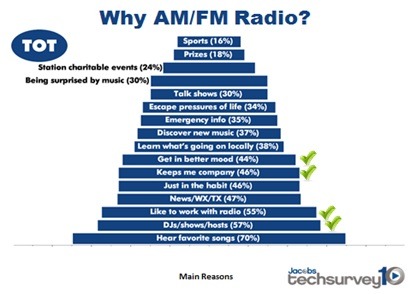 Mike Stern has programmed lots of great radio stations in small markets and Top 5 metros alike. No matter where you go, super fans – or as they are often called, “contest pigs” – are always part of the package. In today’s guest post, Mike takes a look at how one consumer product has approached catering to these over-the-top fans, and how radio can take advantage.
Mike Stern has programmed lots of great radio stations in small markets and Top 5 metros alike. No matter where you go, super fans – or as they are often called, “contest pigs” – are always part of the package. In today’s guest post, Mike takes a look at how one consumer product has approached catering to these over-the-top fans, and how radio can take advantage.
For anyone who thinks it’s difficult to develop innovative new ideas to drive more radio listening, imagine the challenge of trying to move the needle with a cheese product.
That’s why there’s value in learning from the executives at Kraft, the parent company of Velveeta. Yes, Velveeta, the non-refrigerated self-described “cheese food” that flies in the face of the consumer movement against processed foods, as well as growing interest in more upscale, gourmet types of cheese.
According to a Nielsen Newswire article, Velveeta sales were in decline until they engaged the product’s “super consumers” – a subset of the product’s heavy users who not only purchase a lot of Velveeta, but are also engaged with it on an emotional level. Nielsen’s research indicates this group comprises about 10% of a product’s buyers but delivers between 30 and 70 percent of its sales. And let’s be honest, if Velveeta has them, your station surely does.
 The main insight from Velveeta’s “super consumers” was an interest in more ways to use the product, especially those involving melting the brick to make cheese dip. So, among other moves, Kraft started collecting recipes and finding ways to share them among faithful users.
The main insight from Velveeta’s “super consumers” was an interest in more ways to use the product, especially those involving melting the brick to make cheese dip. So, among other moves, Kraft started collecting recipes and finding ways to share them among faithful users.
What makes Kraft’s approach stand out compared to most consumer product strategies is the focus on people who are already consuming their product and want to use it more instead of trying to increase consumption by light users or reclaim people who had moved on. The result has been more than $100 million in increased sales and a viable growth strategy for the future.
To get inspiration from your station’s “super consumers,” it’s important to understand who they are. A Harvard Business Review article on the subject stresses that these aren’t just heavy users with a different name. It’s the combination of heavy use and high engagement with a product that sets them apart.
Their passion makes them a great audience for testing out new ideas and even providing suggestions of their own. As Eddie Yoon, principal at the Cambridge Group, a subsidiary of Nielsen, noted, “Most companies just focus on the economics part of the equation and overlook the emotional part that could be used to grow much faster.” For our stations that’s the equivalent of focusing on rotations and test scores instead of brand appeal and user experience.
All of this sounds like satisfying the P1s, that’s precisely what these programs are all about. In fact, the Harvard article cites Pareto’s Principle, “The 80:20 Rule,” which has guided our decade-long Techsurvey project. By focusing on core consumers – and really listening to them – radio brands can get better, grow, make the emotional connection, and serve audiences better.
Just based on the results of Techsurvey10, we know that people listen to our stations for emotional reasons, including the connection with DJs, companionship, and mood elevation.
And both articles note that between social media and consumer databases, it is easier than ever to find your Super Consumers and get feedback from them. At a time when innovation is more important than ever in keeping brands healthy, it’s time to pay more attention to what our “super consumers” are saying about our stations.
By getting closer to our biggest fans, it might just help us make a lot more cheese.
Most of Nielsen’s case studies revolve around consumer products like Velveeta or television. Tomorrow, Fred will take a look at how radio can create its own super consumer programs, along with an example of a very successful one that’s been in place for nearly three years.
- What To Do If Your Radio Station Goes Through A Midlife Crisis - April 25, 2025
- A 2020 Lesson?It Could All Be Gone In A Flash - April 24, 2025
- How AI Can Give Radio Personalities More…PERSONALITY - April 23, 2025





Radio will be increasingly challenged in forging emotional bonds with its superfans if it continues to replace its emotion points (people) with software. There’s an article in the most recent issue of Time that says a survey of financial people reveals that 78% would do something that IS NOT in their company’s best interest in order to meet Wall Street expectations. Radio has surely hurt itself in that way. ALong those lines, its hard to know what those superfans (P1s) want if you don’t spend some $ to research them and find out. Yes, social media can help you here, but only if used properly without an ROI expectation measured in days. What % of radio actually does that?
Not enough has been said about radio’s constant PR spray touting how localism and real people set it apart from the pure plays like Pandora, while they systematically strips all of those differentiation points away.
Can a PC and software program really garner superfans? Radio is living out its own Animal Farm.
Bob, I would add this: only great stations with the infrastructure to support this type of long-term program need apply. In tomorrow’s post, we’ll showcase a station that’s doing it right. Thanks or the comment.
Bob:
Thanks for the thoughts Bob. I agree if we keep focusing on technology instead of engaging people on an emotional level we lose. The ability to engage is one of our advantages.
The beauty of researching Superfans is that they are engaged and willing to participate in research — focus groups, online surveys etc. — for little or no reward. They like the brand, want to use it more and want to be heard.
We just need to listen.
I think there is some truth here about engaging your super fans. My biggest issue with articles like these is the same as it is with (other unnamed large marketing firms) who proclaim the P&G model incessantly. Here is why a packaged goods model of marketing doesn’t work in radio… in the packaged goods world, you are counting actual case sales. That is, every person you can connect with will incrementally increase the amount of product you sell, and each case is countable and real. In the ratings world, it’s panel based. So even your most fervent fans, when you get them, will expire from the panel in some given length of time (average of 9 months), and when you shoot for this very small group (10% of just YOUR users in the example you state) you are more than 90% likely to replace your “heavy user” with a light user, or non-user. The math just doesn’t work for a statistical sample the way it does for actual consumption.
So, the best we can do ends up being… how do you engage the heavy users and keep them happy, while being able to offer Kraft Singles that everyone loves to complement the niche heavy users of Velveeta. Or something like that.
Chase, I appreciate your comments and perspective. You are correct that the true ROI for radio is unmeasurable. Unlike Velveeta, we cannot see “cheese products” flying off the shelf. But the same can be said for lots of things radio stations engage in, including charitable activities. How can you measure good will and the impact that may have on brand equity.
Tomorrow, we’ll highlight a radio station that’s done a nice job with this program. A number of participants have been around for nearly three years, and the group is growing. Obviously, much work needs to be done with the model and it’s not for everyone.
And by the way, I’m passing on those Kraft Singles. Thanks for engaging our comments section, and please weigh big in tomorrow.
In my experience, although you can’t count the radio equivalent of cheese slices, the aggregate result of good decisions creates good results. The old 80/20 rule applies to radio like most other businesses, and in the long run, if you engage and target your heavy users with things that matter to them, they’ll respond. And while any given ratings month many skew one way or another, in the long run it all buffs out. Cater to those P1s ways that are meaningful and it will show up in the ratings.
I have long been a believer in catering to the core (and believe me, I really feel that way when I feel that Delta Airlines or other businesses I frequent don’t treat me with more respect). And the data we continue to see about recommendation and sharing in the social space only reinforce their value and importance. They have influence in their own communities and beyond. If we don’t take care of them, what’s the point? Thanks, Bob.
Prize weasels ,pigs …ect.. Still have to love em. Many times they are there to support the station. Last thing you want is to make them un happy. They have to obey the rules like everyone else. Your station should have those rules in place at all times and broadcast on air. Can’t tell you how many people will remind me of a prize they won off my show ….from 15 years ago ! Best form of promotion is when I see a prize winner go on social media and brag to friends how they just won concert tickets from the station. I know its a balance sometimes…but over all making someone happy with your brand, the benefits are endless .
screamin
Scott, great comment and nice to hear from a guy on the front lines. You see first-hand the impact of touching lives especially in a meat and potatoes town like Detroit. Thanks for taking the time to comment.